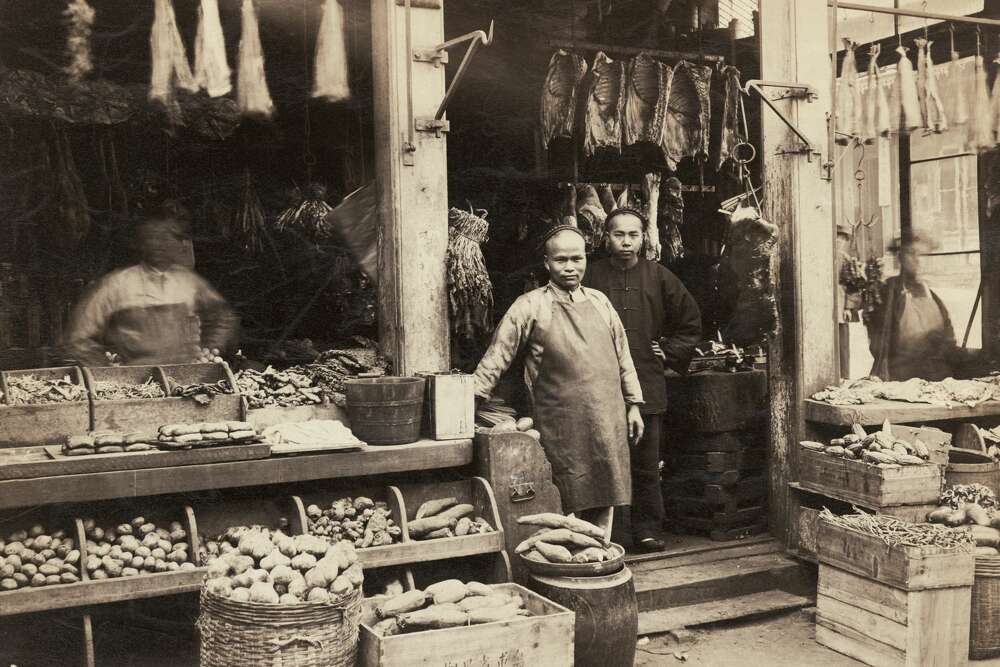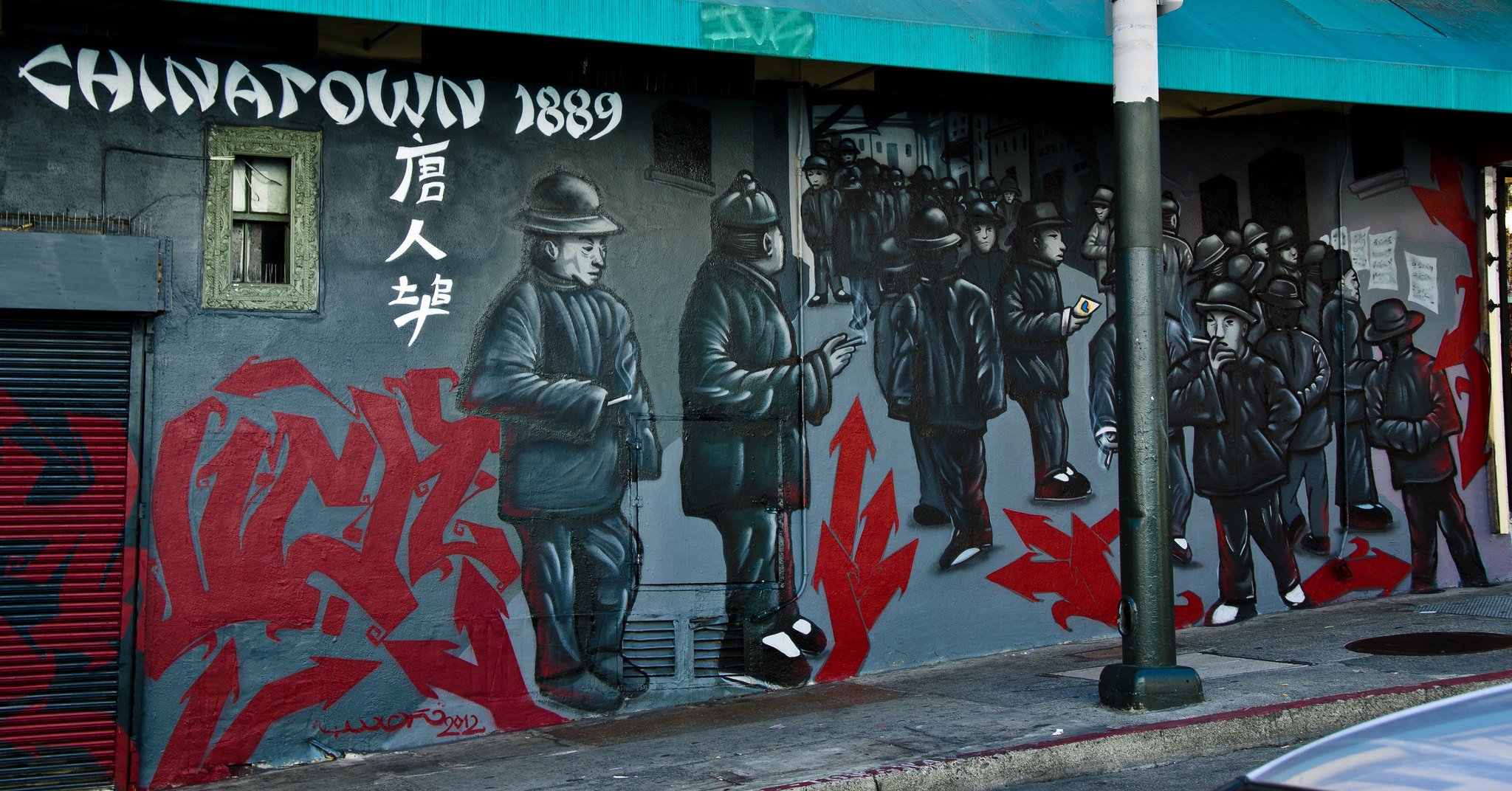U.S. Chinatowns
San Francisco Chinatown, Credit: David Yu
Dragons and Lanterns
Chinatowns are instantly recognizable. Red lanterns are strung high across alleyways; dragons’ tails curl up lamposts; Chinese lettered signs hang from elaborate pagodas. Who are these Chinatowns for? Migrant Footsteps: Look Up explores the reasons why San Francisco’s Chinatown was built with like this. But why did Chinatowns develop in the first place?
Early Chinatowns
The Chinese came to California alongside hundreds of thousands of other migrants from every corner of the globe during California’s 1849 gold rush. These early arrivals — predominantly men arriving from the southeastern province of Canton — banded together in San Francisco. This wasn’t unique to the Chinese: most migrants relied upon countrymen who could speak their language and shared cultural understandings. As the Chinese followed the gold into the foothills of the Sierra, Chinatowns emerged across California, often centre around a temple. But the Chinese rapidly become the target for discrimination and official exclusion. In San Francisco, official city ordinances imposed severe restrictions on Chinese-owned businesses throughout most of the city, so the Chinese community concentrated into ten square blocks in the city center. By 1853, local newspapers had already named this ethnic enclave "Chinatown." It became a place for new arrivals to rely on support and social services from community organizations, find cheap housing, and shield themselves from discrimination and racial violence. As the city grew, so did Chinatown.
Chinatown was a relative safe haven for the Chinese community: but it was also an exclusion zone. Outside the neighborhood, Irish and Italian gangs constantly threatened violence: in 1877, three days of riots across San Francisco left two men dead and Chinese laundries across the city burnt. This was not unusual: on the West Coast, riots burnt Chinatowns to the ground in San Jose, Reno, Carson City and Honolulu.
For San Francisco’s white residents, Chinatown loomed large in the collective imagination. Its gambling parlors, opium dens and brothels were constantly described in sensationalist terms and by the 1880s San Francisco was already marketing Chinatown as a tourist destination. Thrill-seeking white tourists were led through Chinatown to stare at a dark, dangerous neighborhood — though much of what they “saw” was faked, in order to satisfy tourists’ demands for exotic drama.
But if some San Franciscans saw profit and intrigue, others saw sin. In 1885 — with anti-Chinese sentiment sky-high — City Hall commissioned a detailed report into Chinatown that was intended to document rampant lawlessness and disease, in the hope this might clear the way to remove the neighborhood from what was now prime downtown real estate. There were real public health concerns: by this point Chinatown was overcrowded and underdeveloped, largely because it was so isolated from the rest of the city. Then in 1900, an outbreak of Bubonic plague in the city was traced back to Chinatown, and city officials announced a quarantine in Chinatown — but only for Chinese-owned businesses and residents.
A Chinese butcher and grocery store, San Francisco, c.1895. Credit: Wilhelm Hester, University of Washington Collection,
A vendor standing next to vegetables, eggs and spices for sale at provision market in an alley, San Francisco c.1895 Credit: Wilhelm Hester, University of Washington Collection
Veritable Fairy Palaces
As we hear in Look Up, the 1906 earthquake and subsequent Chinatown remodel marked a watershed moment for the neighborhood. The disneyfied, “Orientalist” architecture conceptualized by Look Tin Eli, and executed by white architects Ross and Burgren, became a blueprint for Chinatowns across the country. There are now Chinatowns in nearly every major U.S. city, and roughly 50 Chinatowns across the U.S. Some of the best known are located in New York, San Francisco, Los Angeles, Washington, D.C., Honolulu, Seattle, Chicago, Philadelphia, Houston and Portland, Oregon. All were created within San Francisco’s distinct brand of pagoda roofs, dragon gates, and bright colors.
“[The new Chinatown will be an] Oriental city of veritable fairy palaces filled with the choicest treasures of the Orient.”
Las Vegas’s Chinatown was constructed in the 1990s, making it one of the newest U.S. Chinatown’s. However, the distinct architectural vernacular of even the country’s newest Chinatowns undeniably echoes the precedent set by San Francisco. Credit: eyefoto via istock
Chinatowns Today
While the first Chinatowns were born largely out of racial exclusion and self protection, they quickly became tourist traps — part of why Look Tin Eli was able to persuade San Francisco’s City Hall to drop its relocation plans was by underscoring how much money could by made from tourism. So who are Chinatowns for? Newly-arrived migrants; Chinese Americans looking to connect with their heritage; white tourists? These tensions are something many Chinatown communities today still wrestle with.
On the one hand, U.S. Chinatowns are geared towards attracting tourists and consumers. The architecture and decor are not authentically Chinese, but rather mimic a version of China to strike a delicate balance of seeming “exotic” but palatable and safe for outsiders. Hundreds of thousands of visitors (along with their cash) flow into the country’s popular Chinatowns like New York, Los Angeles, San Francisco every year. While Chinese businesses thrive, Chinatowns also often perpetuate stereotypes about Chinese culture.
Beyond the gilded storefronts, Chinatowns also still offer affordable housing and serve as portals for new, lower income immigrants. Twenty-four percent of Manhattan's Chinatown residents live below the poverty line, and myriad community and social organizations are set up in Chinatowns to support new arrivals in accessing legal services, housing and jobs.
Today, Chinatowns serve as the cultural home for a city’s Chinese community. In San Francisco, the neighborhood has its own dance and music groups, a children's orchestra, artists, a Chinese Culture Center, and the Chinese Historical Society of America. These organizations help foster Chinese American culture, and spearhead community initiatives to help combat the anti-Asian xenophobia and hatred still present today.
In San Francisco, many murals in Chinatown tell the story of Chinese exclusion and Chinese resistance, helping to keep these memories present in the neighborhood. Credit: Merri.
Chinatowns continue to evolve. Many traditional Chinatowns across the US have largely disappeared since the 1960s. This could be seen as a loss — or a sign that after the Chinese Exclusion Act was finally fully reversed in 1965, Chinatowns are no longer needed because there are more opportunities for inclusion and more Chinese Americans have found economic success and moved to less crowded neighborhoods. In San Francisco, there are now four “Chinatowns” — though the communities centered around Noriega, Irving and Clement streets in the West of the city are largely invisible to tourists.





